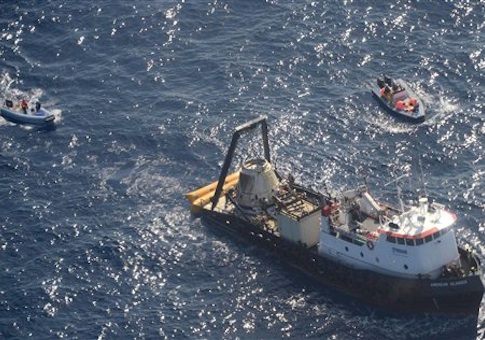Swarms of highly intelligent militarized robots are predicted to hit the battlefield in the near future and could spark a modern day arms race, according to a report released Monday by the Center for a New American Security (CNAS).
Teams of interconnected robots will change the way America and other countries fight their wars, providing them with more range and the ability to conduct "suicidal missions" without risk to living humans, according to the report, entitled, "Robotics on the Battlefield Part II: The Coming Swarm."
The study predicts that in the very near future, advances in technology will allow "swarms of robotic systems" to effect "dramatic, disruptive change to military operations"—and that the United States must significantly step up its focus on these technologies or risk losing its status as the world’s preeminent fighting force.
"Swarms of robotic systems can bring greater mass, coordination, intelligence, and speed to the battlefield, enhancing the ability of warfighters to gain a decisive advantage over their adversaries," the report states.
While the United States and other major powers have made great advances in unmanned technologies—such as drones and other remotely piloted devices—the report predicts that global militaries will soon enter a race to perfect the tactic known as "swarming," in which droves of militarized robots act together on the battlefield.
"Many of the game-changing innovations that enable swarming … will be widely available to a range of actors," the reports states.
However, severe U.S. defense budget cuts known as sequestration threaten to stymie America’s investment into these critical new technologies and could leave the country vulnerable to enemies, according to the report.
"Today the U.S. military faces a pernicious cycle of ever rising platform costs and shrinking quantities," it states. "As a result, the number of combat ships and aircraft in the U.S. inventory has steadily declined, even during periods of significant growth in defense spending."
"Today’s acute fiscal pressures only exacerbate these trends, forcing a crisis not only in military modernization and readiness, but also in the ability to field sufficient quantities to be relevant in future fights," the report warns.
The United States continues to make major investments in "increasingly exquisite systems" in order to compensate for its lack of more nimble robotic technologies. This model, however, "is not sustainable," according to the report, and could allow even rogue state-actors to gain an upper hand over U.S. forces.
"As precision-guided munitions proliferate to other adversaries—both state and non-state actors—the shrinking numbers of U.S. combat assets becomes a major strategic liability," the report warns. "Adversaries can concentrate their weapons, which are becoming increasingly accurate and capable at ever-longer ranges, on the relatively small number of U.S. ships and bases, overwhelming their defenses."
The American military is not yet investing enough in these interconnected unmanned systems, which would actually cost less in the long run, the report says.
"A new paradigm is needed, one that sustains the qualitative superiority of U.S. forces in aggregate, but that disperses combat power among a greater number of platforms, increasing resiliency and diversity and imposing costs on adversaries," the report says.
"Militaries that figure out how best to employ swarms, along with the doctrine, training, command-and-control structures, and other key enablers needed to support them, will have a significant advantage over those who do not," the report concludes.
The CNAS report goes on to suggest that the Pentagon begin studying "swarming platforms" and allocate funding for "a multi-year series of experiments" to test various technologies.
A "Defense Robotics Systems Office" also should be created in the Pentagon to coordinate such activities.
The Army, Air Force, and Navy also should be investigating and pursuing fleets of unmanned, interconnected robot technologies, according to the report.
